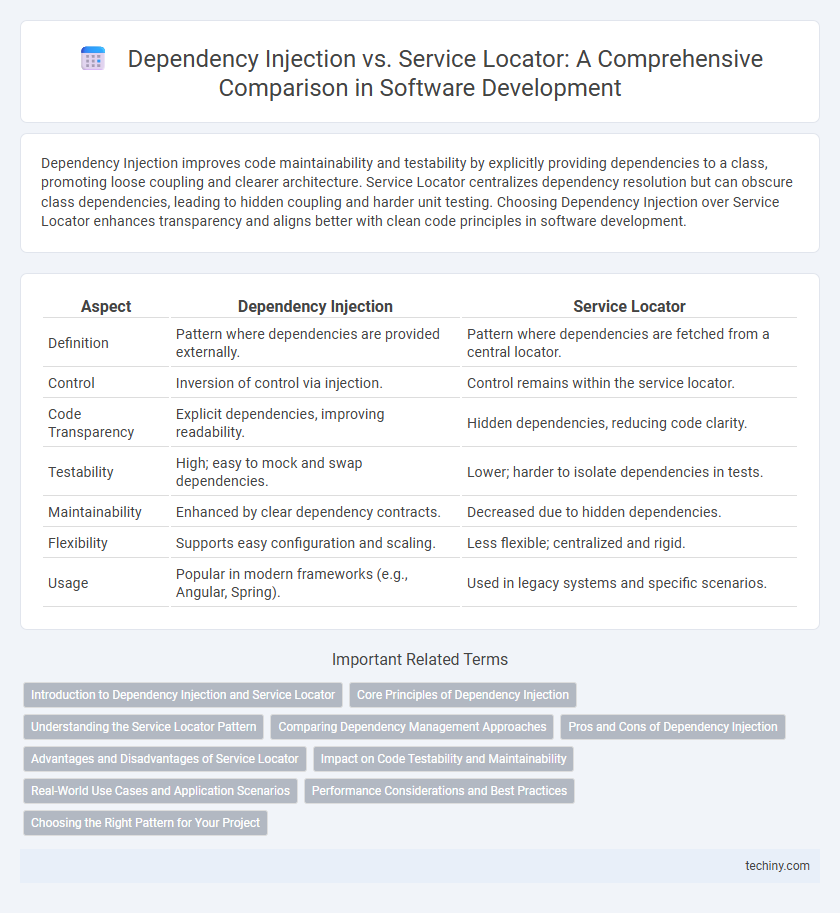Dependency Injection improves code maintainability and testability by explicitly providing dependencies to a class, promoting loose coupling and clearer architecture. Service Locator centralizes dependency resolution but can obscure class dependencies, leading to hidden coupling and harder unit testing. Choosing Dependency Injection over Service Locator enhances transparency and aligns better with clean code principles in software development.
Table of Comparison
| Aspect | Dependency Injection | Service Locator |
|---|---|---|
| Definition | Pattern where dependencies are provided externally. | Pattern where dependencies are fetched from a central locator. |
| Control | Inversion of control via injection. | Control remains within the service locator. |
| Code Transparency | Explicit dependencies, improving readability. | Hidden dependencies, reducing code clarity. |
| Testability | High; easy to mock and swap dependencies. | Lower; harder to isolate dependencies in tests. |
| Maintainability | Enhanced by clear dependency contracts. | Decreased due to hidden dependencies. |
| Flexibility | Supports easy configuration and scaling. | Less flexible; centralized and rigid. |
| Usage | Popular in modern frameworks (e.g., Angular, Spring). | Used in legacy systems and specific scenarios. |
Introduction to Dependency Injection and Service Locator
Dependency Injection (DI) is a design pattern that improves code modularity and testability by providing dependencies from an external source rather than creating them internally. Service Locator is another design pattern that offers a centralized registry for obtaining services, enabling components to query for their dependencies. Both approaches manage object creation and dependency resolution but differ in transparency and control, with DI promoting explicit dependency management and Service Locator favoring runtime flexibility.
Core Principles of Dependency Injection
Dependency Injection centers on the principle of separating object creation from its usage, promoting loose coupling and enhancing testability by injecting dependencies externally rather than allowing components to fetch them internally. This core concept adheres to the Inversion of Control (IoC) pattern, where the control of creating and managing object lifetimes shifts from the classes themselves to a higher-level framework or container. Emphasizing explicit dependency declaration through constructors or setters ensures better code clarity, easier maintenance, and supports unit testing by allowing mock implementations to be injected.
Understanding the Service Locator Pattern
The Service Locator pattern centralizes the retrieval of dependencies through a registry or container, allowing objects to request instances without knowing their creation details. This approach decouples service consumers from concrete implementations but can obscure dependencies, making the code harder to test and maintain. Understanding the Service Locator's role in managing object lifecycles and its impact on code transparency is essential for architectural decision-making in software development.
Comparing Dependency Management Approaches
Dependency Injection promotes transparent dependency management by injecting required components directly, enhancing testability and reducing coupling. Service Locator centralizes dependency retrieval but can obscure dependencies and make testing more complex due to hidden service resolution. Choosing between these approaches hinges on the balance of maintainability, clarity, and ease of testing within the software architecture.
Pros and Cons of Dependency Injection
Dependency Injection enhances code modularity and testability by decoupling object creation from business logic, promoting easier unit testing and maintainability. However, it can introduce complexity through extensive configuration and require a steep learning curve for developers unfamiliar with inversion of control containers. Its design fosters clear dependencies but may lead to over-engineering in simple projects where lightweight solutions are preferable.
Advantages and Disadvantages of Service Locator
Service Locator centralizes object creation, allowing for easier service retrieval without modifying client code, which can simplify dependency management in complex applications. However, it can obscure dependencies, making the code less transparent and harder to test or maintain, as services are resolved at runtime rather than explicitly declared. This approach may lead to hidden coupling and reduced modularity, hindering clarity and increasing the risk of runtime errors.
Impact on Code Testability and Maintainability
Dependency Injection improves code testability by allowing easy substitution of dependencies with mocks or stubs, leading to more modular and maintainable codebases. Service Locator obscures dependencies by hiding them inside a locator object, which complicates unit testing and increases the risk of tight coupling between components. Choosing Dependency Injection promotes clearer dependency management and easier refactoring, enhancing long-term maintainability in software development.
Real-World Use Cases and Application Scenarios
Dependency Injection (DI) excels in large-scale software projects requiring high testability and clear dependency management, such as enterprise applications built with frameworks like Spring or .NET Core, facilitating easier unit testing and modular design. Service Locator patterns suit legacy systems or smaller applications where direct control over service resolution is necessary without extensive refactoring, often seen in game development or simple desktop applications. In complex real-world scenarios, combining DI for core services with Service Locator for optional plugins balances maintainability and flexibility, optimizing resource management and decoupling.
Performance Considerations and Best Practices
Dependency Injection (DI) offers better performance in software development by enabling compile-time dependency resolution, reducing runtime overhead compared to Service Locator, which relies on runtime service lookup. Best practices recommend using DI for clearer, more maintainable code and improved testability, while Service Locator may introduce hidden dependencies and complicate debugging. Performance optimization involves minimizing service resolution complexity and favoring constructor injection to avoid runtime penalties.
Choosing the Right Pattern for Your Project
Choosing the right pattern for your software project depends on factors such as code maintainability, testability, and complexity management. Dependency Injection promotes loose coupling and easier unit testing by injecting dependencies explicitly, while Service Locator centralizes dependency control but can obscure the system's structure and complicate testing. Evaluate project size, team familiarity, and future scalability to determine whether transparent dependency management or centralized service access better suits your development goals.
Dependency Injection vs Service Locator Infographic

 techiny.com
techiny.com